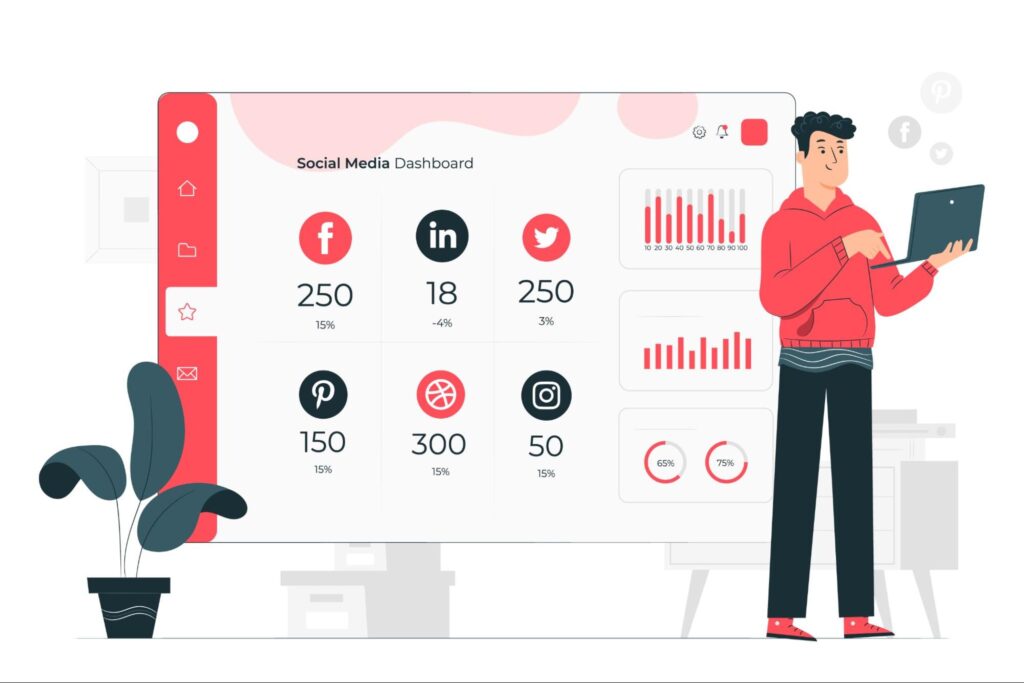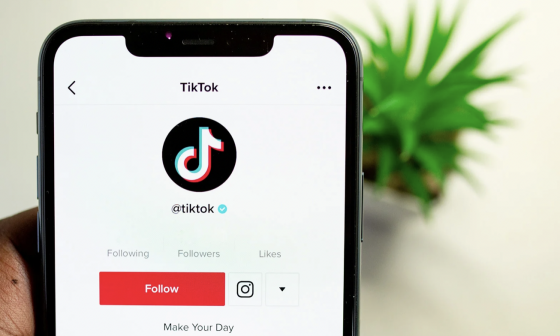Source: Freepik
Trying to grow on social media without a plan is like driving cross-country without a map. Sure, you might get somewhere, but it won’t be where you want to go.
A social media plan gives you direction. It helps you post with purpose, stay consistent, and actually see results. Without one, you’re just guessing—and guessing doesn’t give you engagements or put you in the face of your prospects and customers.
This isn’t about stuffing your feed with random posts and hoping for likes. It’s about creating a system that works, whether you’re a small business, a growing brand, or just tired of talking to an empty audience.
TL;DR: Building an Effective Social Media Plan in a Nutshell
- A social media plan is a roadmap for a brand’s social media presence, covering goals, audience, platforms, content strategy, and execution.
- Essential components of a social media plan include:
- Strategy: Define goals, know your audience, and focus on meaningful engagement.
- Execution: Create high-quality content and post consistently.
- Measurement: Track engagement, reach, and conversions to refine your approach.
- Optimization: Adapt based on trends, data, and platform changes.
- Creating a social media content strategy:
- Optimize social profiles (clear bio, quality visuals, working links).
- Choose the right content formats per platform (videos, images, text, infographics).
- Define a unique brand voice (casual, professional, witty, etc.).
- Create a content calendar to remain consistent and organized.
- Four-Week Social Media Plan:
- Week 1: Research competitors, define content themes, and pick platforms.
- Week 2: Develop brand voice, create content, and plan initial posts.
- Week 3: Engage with the audience, respond to comments, and build community.
- Week 4: Analyze performance, adjust strategies, and plan for the next month.
- Weekly Content Plans by Industry:
- Different post types (educational, engagement, promotional, UGC, trending, behind-the-scenes).
- Industry-specific schedules for e-commerce, real estate, healthcare, tech startups, and restaurants.
- Best Practices for Social Media Success:
- Follow the 50-30-20 rule (50% engagement, 30% curated content, 20% promotions).
- Use the 5-5-5 strategy (like 5 posts, comment on 5, engage with 5 accounts daily).
- Apply the 7 C’s of Social Media (community, content, curation, creation, connection, conversation, conversion).
What is a Social Media Plan?
A social media plan is essentially a strategic document that outlines how a business will approach marketing across social channels.
A social media plan is your brand’s playbook for showing up online and getting noticed. It states your goals, target audience, chosen platforms, content strategy, and tactics to achieve desired outcomes.
It answers four simple questions:
- What are you posting?
- Where are you posting it?
- Why should anyone care?
- What are your aims
A good plan covers four key areas:
1. Strategy: Know Your Audience and Goals
Who are you trying to reach? What do you want them to do? Likes and shares are nice, but real success means people engaging with your brand in a way that actually matters—signing up, buying, and recommending.
2. Execution: Create and Post Consistently
Great content doesn’t post itself. Whether it’s daily updates or weekly deep dives, you need a posting schedule that makes sense for your audience and your team.
3. Measurement: Track What’s Working (and What’s Flopping)
Not every post will be a hit—and that’s fine. But if you’re not tracking engagement, reach, and conversions, you’re flying blind. Data tells you what to double down on and what to drop.
4. Optimization: Adjust and Improve
What worked last month might not work now. A solid social media plan isn’t set in stone—it’s flexible enough to evolve.
Why It’s Important
Think of a social media plan like meal prepping. Sure, you could figure out dinner on the spot every night. But that leads to takeout and regret. With a plan, you’re organized, efficient, and actually getting results.
So, what’s next? Let’s build your plan.
Creating a Social Media Content Strategy
It’s not enough to just post stuff or have a plan. You need a system that makes sure the right people see the right content at the right time. That’s where a solid social media content strategy comes in.
Step 1: Optimize Your Social Media Profiles
Your social media serves as your online marketplace. If they look messy or incomplete, people won’t stick around.
Here’s a quick audit:
- Profile Picture: High-quality logo or professional image. No blurry, old selfies.
- Bio/About Section: Clear, engaging, and to the point. What do you do, and why should people care?
- Links: Make sure they work. Use a link-in-bio tool if you need to share multiple links.
- Contact Info: If you want people to reach out, make it easy.
Small tweaks can make a huge difference. People decide in seconds whether to follow you or move on.
Step 2: Choose the Right Content Formats
Not all content works everywhere. TikTok loves short, snappy videos. LinkedIn is more into thought leadership. Instagram? Visual storytelling!
Pick formats that fit both your brand and the platform.
Here’s a cheat sheet:
- Images: Great for Instagram, Facebook, and LinkedIn. Use high-quality visuals, not just stock photos.
- Videos: Reels, TikToks, YouTube Shorts—video content is effective. Even a 15-second clip boosts engagement.
- Text Posts: Perfect for LinkedIn and Facebook. Tell a story, share insights, and start a conversation.
- Infographics: Data-heavy but easy to digest. Great for LinkedIn, Pinterest, and Instagram.
- Live Streams: Ideal for Q&As, product demos, and behind-the-scenes content. Facebook, Instagram, and TikTok love these.
Your audience decides what works. Test different formats, see what sticks, and do more of that.
Step 3: Define Your Brand Voice
How do you want people to feel when they read your content? Casual? Professional? Witty? Bold?
A few examples:
- Chipotle: Fresh, transparent, casual, conversational. Emphasizes authenticity and humor lightly, making customers feel connected and informed about food sourcing.
- Planet Fitness: Approachable, encouraging, humorous. Reinforces an inclusive, judgment-free environment, often using playful language.
- Starbucks: Warm, personal, inviting. Balances professionalism with friendliness to create a consistent, welcoming atmosphere across global locations.
Your voice should match your audience. If you’re a law firm, cracking jokes like Wendy’s probably isn’t the best move.
Pro tip: Write down a few do’s and don’ts for your brand voice so everyone on your team stays consistent.
Step 4: Build a Content Calendar (And Actually Stick to It)
Posting randomly is a rookie mistake. A content calendar helps you remain consistent and organized.
Here’s what to track:
- Post Date: When is it going live?
- Platform: Where is it being posted?
- Content Type: Video, text, image, infographic?
- Goal: Engagement, brand awareness, sales, clicks?
- Hashtags & Keywords: Keep them relevant, not spammy.
Batch your content in advance. It saves time and keeps you from scrambling for ideas at the last minute. Use scheduling tools like Synup, Buffer, Later, or Hootsuite to automate posts.
Template for a Four-Week Social Media Plan
Building a social media plan from scratch can feel like assembling IKEA furniture without instructions. It’s frustrating, overwhelming, and somehow, you always end up with extra pieces.
But don’t worry, we’ve got the blueprint you need. This four-week plan breaks things down step by step, so by the end of the month, you’ll have a strategy that actually works.
Week 1: Research & Strategy Setup
Before you post anything, you need a game plan. This week is all about research, organization, and laying the groundwork.
1. Research Your Competitors
Understand your competition—identify 3–5 leading brands in your industry that excel on social media.
Study:
- The type of content they post (videos, memes, blogs, customer stories, etc.)
- Posting frequency (daily, weekly, sporadically?)
- Engagement levels (tons of comments, etc.)
- Their best-performing posts (what gets the most likes, shares, and saves?)
Use tools like Synup Social, BuzzSumo, or Sprout Social to analyze trends.
2. Define Your Content Themes
Every great social media plan needs structure. Instead of posting random stuff, create content “buckets” to keep things focused. Some examples:
- Educational Content: Tips, how-tos, industry insights
- Engaging Content: Polls, questions, behind-the-scenes clips
- Promotional Content: Product launches, discounts, case studies
- User-Generated Content (UGC): Customer testimonials, resharing tagged posts
- Trending Content: Viral challenges, memes, industry news
3. Pick the Right Platforms
Not all social media platforms are the same. Find where your audience really is.
- B2B: Focus on LinkedIn & Twitter.
- E-commerce: Instagram, Facebook & TikTok are your best bets.
- Gen Z audience: TikTok & Snapchat.
- Want everything: Try a mix, but don’t stretch yourself too thin.
4. Set Up a Content Calendar
Use tools like Synup Social, Trello, or Notion to map your content. Plan:
- Posting frequency (daily, 3x a week, etc.)
- Best posting times (based on your audience insights)
- Content types (reels, carousels, stories, blog shares)
Pro Tip: Don’t post just for the sake of posting. Quality beats quantity every time.
Week 2: Content Creation & Branding
Now that you have a strategy, it’s time to create scroll-stopping content.
1. Develop Your Brand Voice & Aesthetic
Imagine your brand as a person. Are they funny and witty? Professional and polished? Casual and relatable? Keep your tone consistent across all posts.
Choose brand colors, fonts, and visual styles that make your posts instantly recognizable. Think of brands like Nike and Wendy’s—they have strong voices and signature looks.
2. Start Creating Core Content
Here’s what you should focus on:
Graphics & Images
- Use Canva, Adobe Express, or Figma for designs.
- Branded templates save time and keep things consistent.
- Always use high-quality images (blurry pics are an instant turn-off).
Videos (Short & Long Form)
- TikToks, Reels & YouTube Shorts → Great for engagement & brand awareness.
- Live Q&As → Build trust with your audience.
- Product Demos → Show, don’t just tell.
Blog & Long-Form Content
- Share blog links in your posts to drive traffic.
- Break blog content into bite-sized posts (carousel, infographic, Twitter thread).
- Use LinkedIn articles for professional, in-depth topics.
3. Plan Your First Two Weeks of Posts
You don’t need a year’s worth of content upfront—just the first couple of weeks. Use the themes from Week 1 to create a balanced mix of posts.
Example Week:
- Monday: Educational: “5 Social Media Mistakes to Avoid” (carousel)
- Tuesday: Engaging: “This or That?” (poll)
- Wednesday: Promotional: “Why Our Customers Love Us” (testimonial video)
- Thursday: UGC: Repost a customer’s story
- Friday: Trending: Participate in a viral challenge or industry trend
- Saturday: Behind the Scenes: A peek into your team’s work culture
- Sunday: Rest (yes, even social media needs a break).
Week 3: Engagement & Community Building
Social media isn’t a one-way street. This week is about talking with your audience, not at them.
1. Respond to Every Comment & DM
If someone takes the time to comment, don’t leave them hanging. Reply, like, and keep the conversation going. Social media algorithms love engagement!
2. Engage with Other Accounts
Don’t just focus on your own posts; comment, like, and share content from other brands, influencers, and industry leaders. It helps increase visibility and builds relationships.
3. Run a Small Giveaway or Contest
People love free stuff too. Some will put your handle on post notification for this alone. A small giveaway can skyrocket engagement. Example:
- “Tag a friend who needs this in their life!”
- “Follow, like, and comment to enter!”
- “Share this for a chance to win!”
Make sure the prize is relevant to your brand (giving away an iPhone when you sell coffee won’t attract the right audience).
4. Join or Start a Conversation
Hop onto trending topics. Use Twitter threads, LinkedIn discussions, and Facebook groups to talk about industry trends.
Week 4: Analytics & Optimization
Your social media plan isn’t set and forget. Now, it’s time to analyze what’s working and tweak your strategy.
1. Track Key Metrics
Numbers don’t lie. Keep an eye on:
- Engagement rate (likes, shares, comments)
- Follower growth
- Click-through rates (CTR) on links
- Best-performing posts (and worst—so you can fix them)
Use built-in analytics (Instagram Insights, Facebook Business Suite, Twitter Analytics) or tools like Synup Social to track progress.
2. Double Down on What Works
If video posts are performing well, create more. If engagement on memes is high, add them to your content mix. Social media is all about experimenting and adapting.
3. Adjust Posting Frequency & Strategy
Maybe daily posting is too much for your audience. Maybe LinkedIn is driving more traffic than Instagram. Adjust accordingly based on the data.
4. Plan for Next Month
Now that you have a rhythm, start planning content for the next four weeks. Use insights from your analytics to make smarter decisions.
Your Weekly Social Media Plan Made Easy
Below, you’ll find tailored weekly content plans for five different business types. Each plan balances education, engagement, promotions, and trends, making sure you’re not just posting for the sake of it, but actually driving results.
E-commerce Store Social Media Plan Sample
- Monday (Educational): Blog – “How to Choose the Perfect Running Shoes”
- Tuesday (Engagement): Poll – “What’s your favorite sneaker brand?”
- Wednesday (Promotional): Flash Sale Alert – 20% off all sneakers today only!
- Thursday (UGC): Repost customer review & photo wearing the product
- Friday (Trending): Join trending fashion challenge on TikTok
- Saturday (Behind-the-scenes): Warehouse tour & packing orders video
- Sunday (Rest): Minimal engagement, respond to DMs/comments
Real Estate Agency Social Media Plan
- Monday (Educational): Blog share – “5 Things to Look for When Buying a Home”
- Tuesday (Engagement): Poll – “City apartment or suburban house – which do you prefer?”
- Wednesday (Promotional): New listing alert – 3-bedroom home in downtown for sale!
- Thursday (UGC): Client testimonial – “Buying my first home was stress-free with XYZ Realty!”
- Friday (Trending): Reels – “Common home-buying mistakes to avoid”
- Saturday (Behind-the-scenes): Team introduction – Meet our top agents
- Sunday (Rest): Minimal engagement, respond to DMs/comments
Healthcare Clinic Social Media Plan
- Monday (Educational): Health tip – “5 Easy Exercises to Reduce Back Pain”
- Tuesday (Engagement): Q&A – “What’s your biggest health concern?”
- Wednesday (Promotional): Book consultation today & get a free initial health check!
- Thursday (UGC): Patient testimonial – “Dr. Smith helped me recover from chronic migraines.”
- Friday (Trending): Health awareness post (e.g., Heart Health Month)
- Saturday (Behind-the-scenes): Clinic tour – “A day in the life of our doctors”
- Sunday (Rest): Minimal engagement, respond to DMs/comments
Tech Startup Social Media Plan
- Monday (Educational): Blog share – “Why AI is the Future of Business Automation”
- Tuesday (Engagement): Poll – “What’s the biggest tech challenge in your business?”
- Wednesday (Promotional): Exclusive offer – Free 30-day trial for new users!
- Thursday (UGC): User testimonial – “Synup helped us increase efficiency by 40%!”
- Friday (Trending): Industry news – “Latest updates from the tech world”
- Saturday (Behind-the-scenes): Office culture video – “How we brainstorm new ideas”
- Sunday (Rest): Minimal engagement, respond to DMs/comments
Restaurant Social Media Plan
- Monday (Educational): Chef’s tip – “How to make the perfect pasta sauce”
- Tuesday (Engagement): Poll – “What’s your favorite pizza topping?”
- Wednesday (Promotional): Limited-time special – Buy 1, Get 1 Free on all burgers!
- Thursday (UGC): Customer photo & review – “Best brunch in town!”
- Friday (Trending): Food challenge – “Can you finish our biggest burger in 5 minutes?”
- Saturday (Behind-the-scenes): Kitchen video – “How we prepare our signature dish”
- Sunday (Rest): Minimal engagement, respond to DMs/comments
Stick to this plan for a few weeks, monitor what works best, and tweak it as you go. Social media is always evolving, and so should your strategy.
Remember:
- Quality beats quantity: Better one great post than five forgettable ones.
- Engagement matters: Reply to comments, join discussions, and interact with your audience.
- Track your results: Analyze what’s working and optimize accordingly.
Also Read: 100 Best Social Media Management Tools (Paid & Free)
Summing Up
A strong social media plan starts with a smart content strategy. It’s not about posting more—it’s about posting better.
Focus on the right formats, a strong brand voice, and a clear posting schedule.
Remember, creating a social media plan isn’t about perfection—it’s about progress. Start with this framework, track results, and tweak along the way. Research before you post. Create engaging, valuable content. Talk with your audience, not at them. Analyze, adapt, repeat. The goal is to build a brand people want to follow—not just because you post, but because you provide real value.
Now, create a plan and go make some noise on social! You can schedule and manage your handles using a social tool. Synup can make it easy to manage your social media and has tools to plan your content easily.
Build a Killer Social Media Plan from Scratch: FAQs
What is the 50-30-20 rule for social media?
The 50-30-20 rule makes sure 50% of your content is engaging: fun, relatable, or valuable posts that spark conversations (memes, tips, behind-the-scenes moments). 30% curated content—sharing interesting posts from others in your industry so your page isn’t a one-way street. 20% promotional content—talking about your products or services but without sounding like a pushy salesperson.
What is the 5-5-5 social media strategy?
The 5-5-5 rule is all about liking 5 posts, commenting on 5 posts, and engaging with 5 accounts—all in five minutes. That’s it. It is the easiest way to stay active without getting sucked into a social media black hole. More engagement means more visibility, which means more potential customers noticing your brand. Social media is a two-way street—when you show up for others, they’re more likely to show up for you.
What are the ABCs of social media marketing?
A is for Audience: know who walks through your door, what they like, and why they keep coming back. B is for Branding: your vibe, your message, your signature style (like that café with the amazing latte art everyone Instagrams). C is for Content with Consistency: because posting once in a blue moon won’t cut it. Whether it’s daily or weekly, just keep showing up.
What are the 7 C’s of social media strategy?
The 7 C’s of social media strategy – community, content, curation, creation, connection, conversation, and conversion – are what make your brand more than just another account in the feed. Community thrives on relationships, not just numbers. Keep people engaged with content, add value through curation, and stand out with original creation. True connection comes from interaction, not just posting. Conversations humanize your brand, leading to conversions that drive business.



